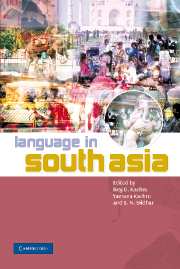Book contents
- Frontmatter
- Contents
- List of Figures
- List of Maps
- List of Tables
- Preface
- Acknowledgments
- List of Abbreviations
- Note on Transcription
- Introduction: languages, contexts, and constructs
- Part 1 Language history, families, and typology
- 1 Language in historical context
- 2 Typological characteristics of South Asian languages
- Part 2 Languages and their functions
- Part 3 Sanskrit and traditions of language study
- Part 4 Multilingualism, contact, and convergence
- Part 5 Orality, literacy, and writing systems
- Part 6 Language conflicts
- Part 7 Language and modernization
- Part 8 Language and discourse
- Part 9 Language and identity
- Part 10 Languages in diaspora
- References
- Subject Index
- Language Index
- Author Index
2 - Typological characteristics of South Asian languages
Published online by Cambridge University Press: 04 May 2010
- Frontmatter
- Contents
- List of Figures
- List of Maps
- List of Tables
- Preface
- Acknowledgments
- List of Abbreviations
- Note on Transcription
- Introduction: languages, contexts, and constructs
- Part 1 Language history, families, and typology
- 1 Language in historical context
- 2 Typological characteristics of South Asian languages
- Part 2 Languages and their functions
- Part 3 Sanskrit and traditions of language study
- Part 4 Multilingualism, contact, and convergence
- Part 5 Orality, literacy, and writing systems
- Part 6 Language conflicts
- Part 7 Language and modernization
- Part 8 Language and discourse
- Part 9 Language and identity
- Part 10 Languages in diaspora
- References
- Subject Index
- Language Index
- Author Index
Summary
Introduction
Linguistics as a discipline is concerned with discovering language universals and coming up with an explanation for them in order to characterize the human linguistic faculty. There are two major approaches that linguists have followed in their explanation for language universals (Comrie 1981). One is associated with the innateness hypothesis formulated by Chomsky and his followers, and the other with linguistic typological research as proposed by Greenberg (1966). The first approach adopts the methodology of studying of a small number of languages in-depth and providing a statement of language universals in terms of very abstract structures. The assumption is that discovering general principles of linguistic organization and constraints that operate on them is necessary and sufficient to characterize the innate human linguistic ability. According to this view, all the human beings have the innate capability to acquire language. All languages share a set of common principles that are called language universals. These universals are not language specific. These common principles constitute what is called the Universal Grammar (UG). UG is genetically endowed and hence is embedded in the human mind. UG is prior to experience (i.e. exposure of the child to any specific language). Further, UG is species specific. In the words of Chomsky (1981: 7), “Universal Grammar may be thought of as some system of principles common to the species and available to each individual prior to experience.
- Type
- Chapter
- Information
- Language in South Asia , pp. 49 - 78Publisher: Cambridge University PressPrint publication year: 2008
- 45
- Cited by



